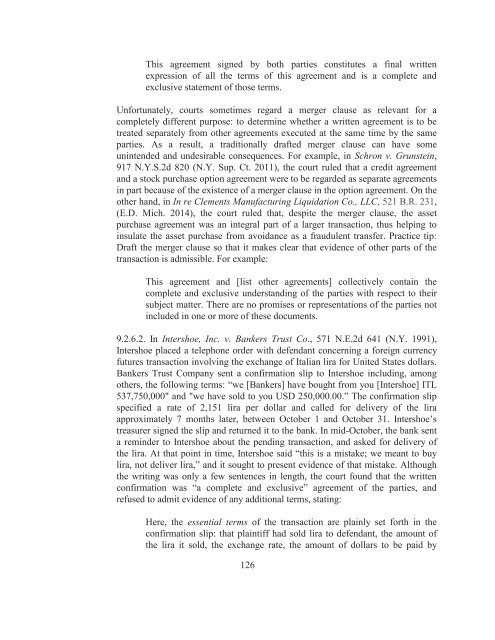Sales and Leases - A Problem-based Approach, 2016a
Sales and Leases - A Problem-based Approach, 2016a
Sales and Leases - A Problem-based Approach, 2016a
Create successful ePaper yourself
Turn your PDF publications into a flip-book with our unique Google optimized e-Paper software.
This agreement signed by both parties constitutes a final written<br />
expression of all the terms of this agreement <strong>and</strong> is a complete <strong>and</strong><br />
exclusive statement of those terms.<br />
Unfortunately, courts sometimes regard a merger clause as relevant for a<br />
completely different purpose: to determine whether a written agreement is to be<br />
treated separately from other agreements executed at the same time by the same<br />
parties. As a result, a traditionally drafted merger clause can have some<br />
unintended <strong>and</strong> undesirable consequences. For example, in Schron v. Grunstein,<br />
917 N.Y.S.2d 820 (N.Y. Sup. Ct. 2011), the court ruled that a credit agreement<br />
<strong>and</strong> a stock purchase option agreement were to be regarded as separate agreements<br />
in part because of the existence of a merger clause in the option agreement. On the<br />
other h<strong>and</strong>, in In re Clements Manufacturing Liquidation Co., LLC, 521 B.R. 231,<br />
(E.D. Mich. 2014), the court ruled that, despite the merger clause, the asset<br />
purchase agreement was an integral part of a larger transaction, thus helping to<br />
insulate the asset purchase from avoidance as a fraudulent transfer. Practice tip:<br />
Draft the merger clause so that it makes clear that evidence of other parts of the<br />
transaction is admissible. For example:<br />
This agreement <strong>and</strong> [list other agreements] collectively contain the<br />
complete <strong>and</strong> exclusive underst<strong>and</strong>ing of the parties with respect to their<br />
subject matter. There are no promises or representations of the parties not<br />
included in one or more of these documents.<br />
9.2.6.2. In Intershoe, Inc. v. Bankers Trust Co., 571 N.E.2d 641 (N.Y. 1991),<br />
Intershoe placed a telephone order with defendant concerning a foreign currency<br />
futures transaction involving the exchange of Italian lira for United States dollars.<br />
Bankers Trust Company sent a confirmation slip to Intershoe including, among<br />
others, the following terms: “we [Bankers] have bought from you [Intershoe] ITL<br />
537,750,000" <strong>and</strong> "we have sold to you USD 250,000.00.” The confirmation slip<br />
specified a rate of 2,151 lira per dollar <strong>and</strong> called for delivery of the lira<br />
approximately 7 months later, between October 1 <strong>and</strong> October 31. Intershoe’s<br />
treasurer signed the slip <strong>and</strong> returned it to the bank. In mid-October, the bank sent<br />
a reminder to Intershoe about the pending transaction, <strong>and</strong> asked for delivery of<br />
the lira. At that point in time, Intershoe said “this is a mistake; we meant to buy<br />
lira, not deliver lira,” <strong>and</strong> it sought to present evidence of that mistake. Although<br />
the writing was only a few sentences in length, the court found that the written<br />
confirmation was “a complete <strong>and</strong> exclusive” agreement of the parties, <strong>and</strong><br />
refused to admit evidence of any additional terms, stating:<br />
Here, the essential terms of the transaction are plainly set forth in the<br />
confirmation slip: that plaintiff had sold lira to defendant, the amount of<br />
the lira it sold, the exchange rate, the amount of dollars to be paid by<br />
126


















